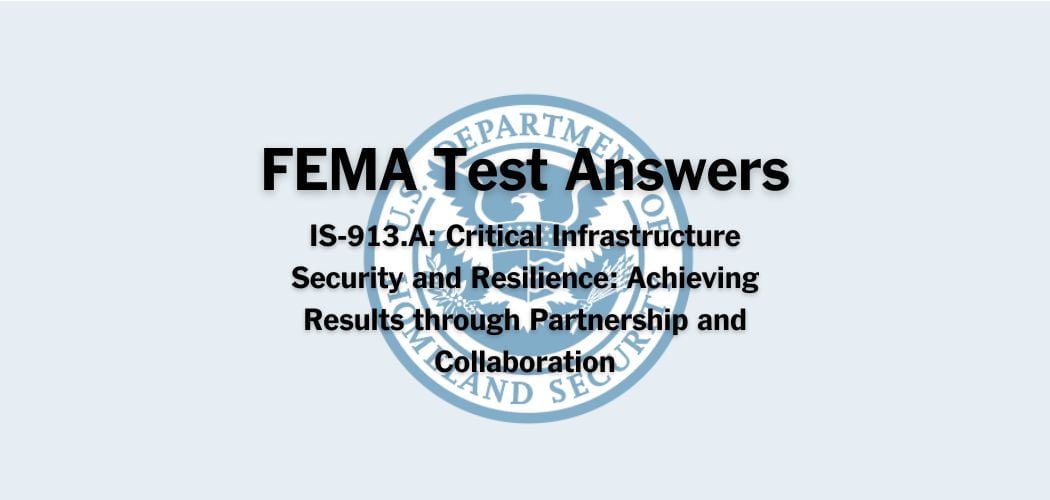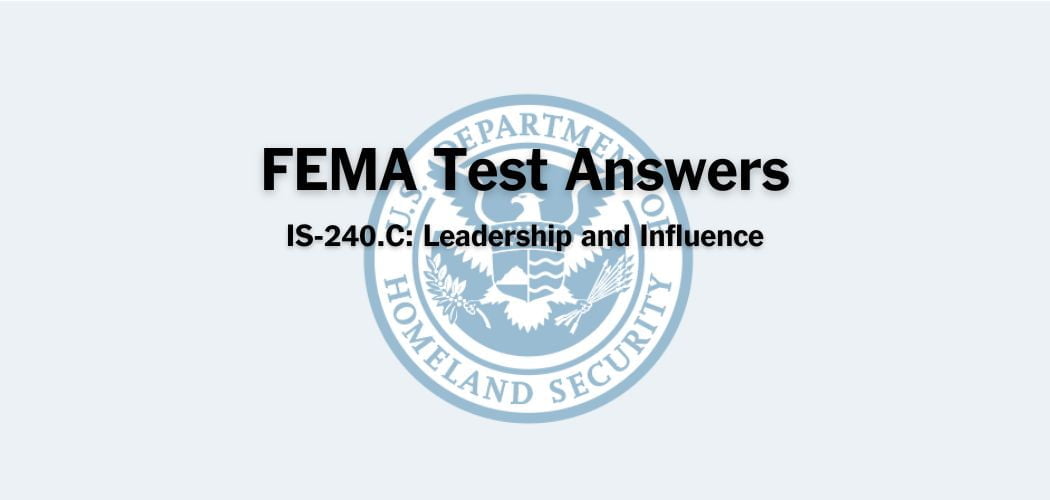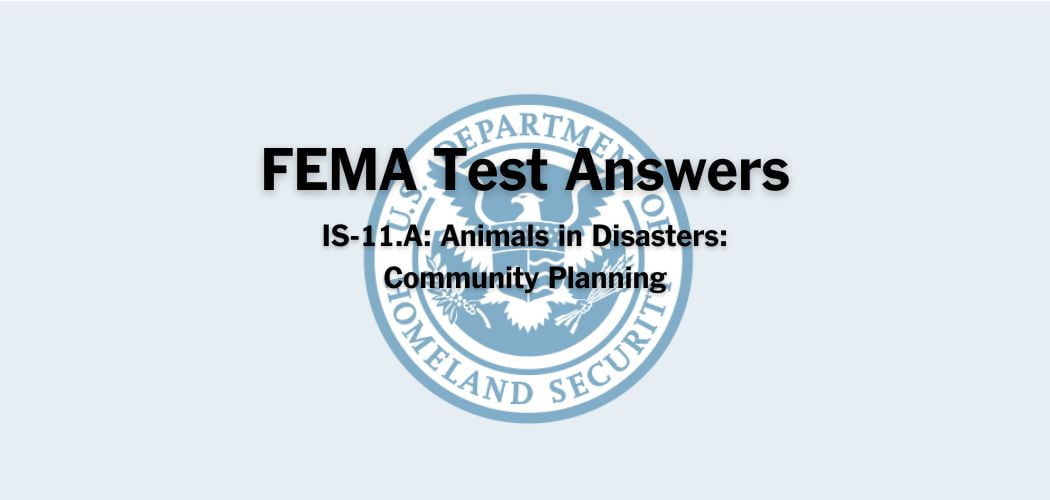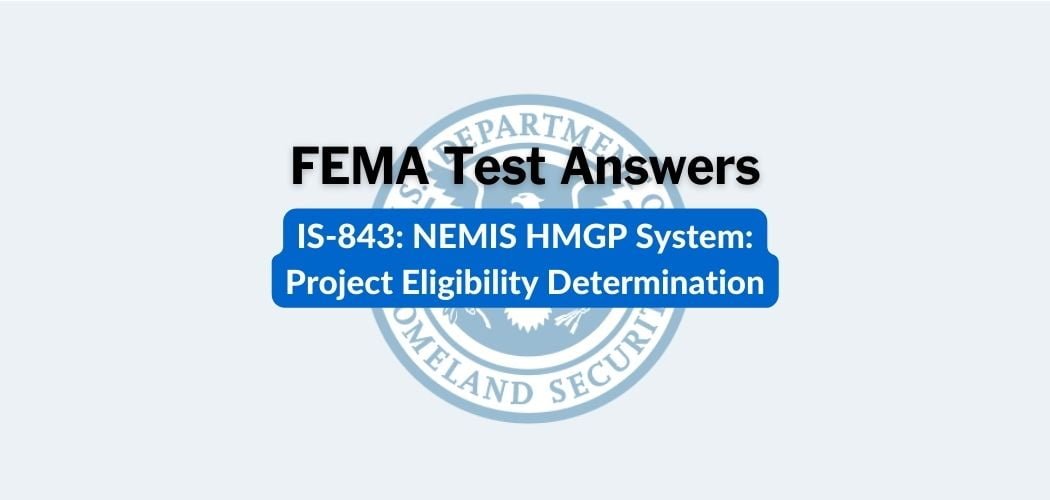Overview: The FEMA IS-156 course was published on 6/12/2014 to provide guidance to the building sciences community working for public and private institutions, including Continuity of Operations (COOP) planners/managers, building officials, etc.
IS-156 course presents tools to help decision-makers assess the performance of their buildings against terrorist threats and to rank recommendations. It is up to the decision-makers to decide which types of threats they wish to protect against and to determine their level of risk against each threat. Those decision-makers who consider their buildings to be at high risk can use this guidance as necessary
FEMA IS-156 test answers
Each time this test is loaded, you will receive a unique set of questions and answers. The test questions are scrambled to protect the integrity of the exam.
Question 1. A _______ is an action, device, or system used to reduce risk by affecting an asset, threat, or vulnerability.
A. Defensive corollary
B. Consequence
C. Aggressor tactic
D. Mitigation measure✅
Question 2. Personal protective equipment is only effective against specific agents if:
A. The PPE is stored in warm dry office space
B. The HVAC system is turned off and the building is sealed
C. The purchased equipment is one size fits all
D. The PPE is worn correctly when needed✅
Question 3. The consequences are defined as the degree of _______ that is caused by the loss of an asset.
A. economic disruption
B. productivity interruption
C. debilitating impact✅
D. customer dissatisfaction
Question 4. A vulnerability can be described as a weakness that can be exploited by someone, or, a weakness that would make a facility susceptible during a natural disaster.
A. TRUE✅
B. FALSE
Question 5. Brittle materials such as glass are most affected by?
A. Impulse Wave
B. Peak incident pressure✅
C. Shock wave
D. Both A & B
Question 6. Which biological agents are contagious
A. Anthrax
B. Salmonella
C. Ricin
D. Smallpox ✅
Question 7. Which of the following public areas should be separated from areas requiring more security by the use of buffer zones?
A. Warehouses
B. Parking areas
C. Retail establishments
D. Lobbies
E. All of the above✅
Question 8. What preparations are needed in order to safely shelter in place?
A. Lan ports for laptops, printer paper, office supplies, food and water, Duct tape and plastic, plants
B. Permanently sealed room, direct phone line, 1 gallon of water per person per day, good ventilation
C. Supplies to seal the room, HVAC shutoff, carbon dioxide absorbers, food and water, communications, and a well-practiced plan✅
D. Supplies to seal the room, HEPA filter, food and water, windows, and a well-practiced plan
Question 9. When designating or designing a Continuity of Operations (COOP) facility, which hazards should be considered?
A. Man-made
B. Natural
C. terrorist
D. All of the above✅
Question 10. Lacerations occur the furthest distance from an explosive event as a result of:
A. Sub-standard structural components.
B. High-velocity glass fragments.
C. Projectile debris from progressive collapse✅
D. blast loading effects of the 2/3’s conflagration.
Question 11. Of all blast mitigation measures which is the most effective?
A. added steel reinforcement
B. thicker glass veneer
C. increased stand-off distance
D. All are equally effective✅
Question 12. CBR detectors can not be successfully integrated into the building’s security operations center and building automation systems.
A. TRUE
B. FALSE✅
Question 13. When estimating the direct consequences of an attack you should consider, the target, the effect of the weapon, physical and environmental conditions, and _______?
A. estimated damage
B. how many people work in the building
C. cascading effects
D. potential losses✅
Question 14. Continuity programs are a required and critical component of Government and critical infrastructure operations, and during emergencies and disasters, ensure that the Government at all levels can continue to operate and provide essential functions and services.
A. TRUE
B. FALSE✅
Question 15. The concept of Design Basis Threat (DBT) is essential to building protection because?
A. DBT establishes the minimum criteria necessary for the proper selection of window thickness and fragment retention films.
B. DBT provides a means to identify and characterize all threat groups operating in the local area that could impact the building’s occupancy.
C. DBT provides the mitigations necessary to ensure that standoff is kept to a minimum.
D. DBT establishes the threat tactics that architects and engineers use in designing mitigations for a new structure or renovation.✅
Question 16. A threat is any indication, circumstance, or event with the potential to cause loss of or damage to an asset.
A. TRUE✅
B. FALSE
Question 17. Which type of map can be used for establishing emergency evacuation routes?
A. Emergency response map
B. 10-mile radius map
C. metro center map
D. regional transportation map✅
Question 18. Which of the following is the least desirable type of passive barrier, in terms of its vehicle-stopping ability, aesthetics, effect on pedestrian access, and performance in blast loading?
A. Berms
B. Bollards
C. reinforced street furniture
D. Jersey Barriers✅
Question 19. In some cases, the best mitigation measure may be to do nothing.
A. TRUE✅
B. FALSE
Question 20. According to the FEMA 452 Manual which tier of Risk Assessment methodology requires using blast and WMD models?
A. Tier I✅
B. Tier II
C. Tier III
D. Tier IV
Question 21. Risk is a combination of: The probability that an event will occur, and the probability that a terrorist will be able to successfully plan an attack.
A. TRUE
B. FALSE✅
Question 22. Assessing a building’s vulnerabilities requires a multi-disciplinary team. It should not be conducted solely by an engineer or security specialist.
A. TRUE✅
B. FALSE
Question 23. Assembling a GIS Portfolio can help in performing a Vulnerability Assessment on a continuity facility.
A. TRUE✅
B. FALSE
Question 24. Layers of defense are used to provide?
A. A basis for the design-based threat.
B. justification for funding expenditures for new technology.
C. defensive barriers to channel hostile vehicles toward active barriers.
D. Multiple opportunities to detect and defeat an aggressor.✅
Question 25. Activated Carbon filters are designed to filter a broad range of toxic chemicals, but not all chemicals.
A. TRUE✅
B. FALSE
Question 26. When conducting a building assessment which of the following should be a member of the multifunctional team?
A. engineer/ architect
B. Security
C. Emergency Manager
D. subject matter experts
E. All of the above✅
Question 27. Which risk management choice achieves the lowest Risk but has the greatest cost?
A. Install an electrified fence with razor wire
B. Do nothing
C. Harden the building✅
D. Install bollards
Question 28. The geographical isolation of the United States is a sufficient barrier to preventing terrorist attacks?
A. TRUE
B. FALSE✅
Question 29. The four main categories of consequences are?
A. Human impacts, economic impacts, public confidence, and re-election impacts
B. Impacts of government ability, damage to the company name, distribution of product lines, loss of life
C. Human impacts, economic impacts, public confidence impacts, and impacts on government ability✅
D. Loss of life, loss of communications, loss of revenue, loss of client base
Question 30. Resilience is the ability of an organization or asset to _______ its critical functionality in a short period of time after the impact of an adverse event.
A. maintain or recover quickly✅
B. contract or transfer the responsibility of
C. gracefully shut-down computer functions of
D. Back-up data for
Question 31. Which of the following is not an infrastructure single-point vulnerability common in commercial facilities?
A. entry/exit points
B. electrical
C. water
D. telecom
E. All of the above✅
Question 32. A single-point vulnerability is:
A. A critical infrastructure component with redundant feeds and back-ups
B. Multiple nodes and distribution paths
C. Critical components or systems with more than 100 feet of separation
D. A point where multiple systems come together and an incident at this location could cause multiple systems to be taken down✅
Question 33. The best way to lower peak incident pressure and the reflective wave is?
A. Decrease the distance of detonation
B. increase distance of detonation✅
C. peak incident pressure does not cause damage
D. reflective wave does not matter
Question 34. A _______ is any weakness that can be exploited by an aggressor or, in a non-terrorist threat environment, make an asset susceptible to hazard damage.
A. Consequence
B. design flaw
C. Remunerability
D. Vulnerability✅
Question 35. The consequences resulting from a pandemic would primarily impact which two areas?
A. Human
B. Economic
C. Public confidence
D. Government ability
E. A & B✅
Question 36. Core functions can include all of the following, EXCEPT:
A. Primary services or outputs.
B. Critical activities.
C. inputs from external organizations.
D. Building utilities.✅
Question 37. The process of making the site or building of little to no value or consequence, from the terrorists’ perspective, such that an attack on the facility would not yield their desired result.
A. Deter
B. Detect
C. Devalue✅
D. Deny
Question 38. The third layer of defense determines which of the following?
A. Angle of incidence
B. Stand-off distance required✅
C. Amount of explosive
D. Reflected pressure over the exterior of the building
Question 39. A numeric risk value can be computed once the following information is known:
A. Design Basis threat, level of protection, defensive layers
B. Threat rating, consequence rating, vulnerability rating✅
C. building ranking, mitigation, level of protection
D. Threat rating, vulnerability rating, design basis threat
Question 40. Which item is an example of a threat and/or hazard that could potentially impact a building or site?
A. Bombing
B. Armed Attack
C. Kidnapping
D. All of the above✅
Question 41. Mitigation measures can be conducted by which of the following means?
A. Regulatory measures
B. Rehabilitation of facilities
C. Protective and control structures
D. all of the above✅
Question 42. In most cases trying to add security measures into facility planning proves to be too costly.
A. TRUE
B. FALSE✅
Question 43. Consequences can include the _______ and cost for infrastructure and equipment, it can also include lost profit or a lost capability.
A. replacement time✅
B. cost
C. loss of personnel
D. loss of an essential function
Question 44. Risk is defined as the probability of event times the consequences if it occurs.
A. TRUE✅
B. FALSE
Question 45. The initial step of a risk assessment is to:
A. Evaluate the security master plan.
B. Define and understand a building’s core functions and processes, and identify building infrastructure.✅
C. Interview staff to determine if there are alternates assigned to key functions.
D. Collect site data from interactive GIS maps.
Question 46. What is the primary method of terrorist attack according to NCTC?
A. bombings and arson
B. kidnapping
C. CBR attacks and firebombing
D. armed attack and bombings✅
Question 47. The most commonly selected terrorist targets, worldwide, are?
A. Military bases
B. Government facilities
C. Law enforcement facilities
D. Commercial facilities✅



